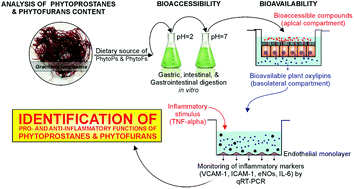Bioavailable phytoprostanes and phytofurans from Gracilaria longissima have anti-inflammatory effects in endothelial cells
Abstract
Background: An array of bioactive compounds with health-promoting effects has been described in several species of macroalgae. Among them, phytoprostanes (PhytoPs) and phytofurans (PhytoFs), both autoxidation products of α-linolenic acid, have been seen to exert immunomodulatory and antiinflammatory activities in vitro. The purpose of this study was to explore the bioaccesibility, bioavailability, and bioactivity of PhytoPs and PhytoFs obtained from the edible red algae Gracilaria longissima, and to gain insight into the anti-inflammatory activity of their bioavailable fraction in human endothelial cells. Methods: The PhytoPs and PhytoFs profile and concentration of G. longissima were determined by UHPLC-QqQ-MS/MS. Algal samples were processed following a standardised digestion method including gastric, intestinal, and gastrointestinal digestion. The bioavailability of the PhytoPs and PhytoFs in the characterized fractions was assessed in a Caco-2 cell monolayer model of the intestinal barrier. The inflammation response of these prostaglandin-like compounds in human endothelial cells, after intestinal absorption, was investigated in vitro. Results: Simulated digestions significantly reduced the concentration of PhytoPs and PhytoFs up to 1.17 and 0.42 μg per 100 g, respectively, on average, although permeability through the Caco-2 cell monolayer was high (up to 88.2 and 97.7%, on average, respectively). PhytoP and PhytoF-enriched extracts of raw algae impaired the expression of ICAM-1 and IL-6 inflammation markers. The inflammation markers progressed in contrast to the relative concentrations of bioactive oxylipins, suggesting pro- or anti-inflammatory activity on their part. In this aspect, the cross-reactivity of these compounds with diverse receptors, and their relative concentration could explain the diversity of the effects found in the current study. Conclusions: The results indicate that PhytoPs and PhytoFs display complex pharmacological profiles probably mediated through their different actions and affinities in the endothelium.



 Please wait while we load your content...
Please wait while we load your content...